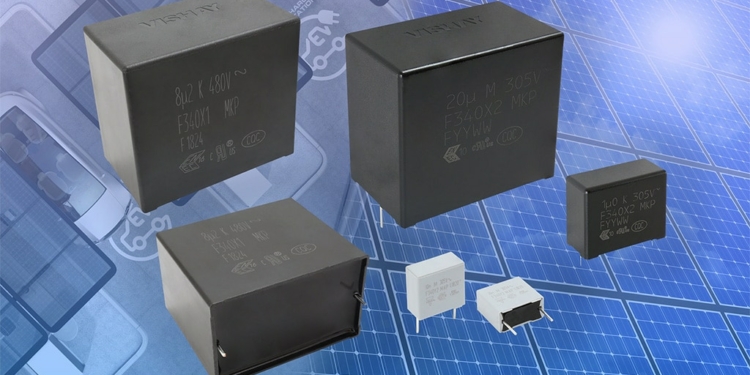Source: Vishay news
MALVERN, Pa. Vishay Intertechnology, Inc. today introduced three new series of X1, X2, and Y2 electromagnetic interference (EMI) suppression film capacitors for standard across the line and line bypass applications.
Designed to meet the most stringent requirements for robustness against humidity, the new F340 EMI suppression family is certified to IEC 60384-14: 2013 ed. 4 / AMD1: 2016 grade IIIB: “High Robustness Under High Humidity.”
To comply with the humidity grading system defined under IEC 60384-14: 2013 ed. 4 / AMD1: 2016 grade IIIB, the Vishay BCcomponents devices released today withstand temperature humidity bias (THB) testing of 85 °C, 85 % relative humidity for 1000 hours while biased at the rated AC voltage with high stability on capacitance, dissipation factor, and insulation resistance. This translates into longer service life under harsh application conditions for industrial and automotive power electronics, such as battery chargers, renewable energy inverters, motor drives, and UPS.
The F340X1 is designed for a rated voltage of 480 VAC. It offers a broad capacitance range from 0.22 µF to 8.2 µF, while withstanding operation voltages up to 530 VAC to ensure compliance with permissible voltage variations on three-phase mains. The F340X2 has a rated voltage of 305 VAC and provides a capacitance range from 1 µF to 20 µF, with high ripple current capabilities up to 18 A at 10 kHz. Also featuring a rated voltage of 305 VAC, the F340Y2 is qualified in accordance with AEC-Q200, Automotive Grade and provides a capacitance range from 0.01 µF to 1 µF.
The entire F340 family is certified in accordance with EN, UL and CQC for Safety and Humidity Robustness. The capacitors offer lead pitches of 15 mm, 22.5 mm, 27.5 mm, 37.5 mm and 52.5 mm. Their encapsulation consists of a flame-retardant UL-class 94 V-0 plastic case and epoxy resin sealing. All three series are lead (Pb)-free and RoHS-compliant; F340X1 480VAC and F340X2 305VAC devices are also halogen-free and Vishay Green.
Device Specification Table:
| Series | F340X1 480VAC | F340X2 305VAC | F340Y2 305VAC |
| Capacitance | 0.22 μF to 8.2 μF | 1 μF to 20 μF | 0.01 μF to 1 μF |
| Tolerance | ± 10 %; ± 20 % | ± 10 %; ± 20 % | ± 5 %; ± 10 %; ± 20 % |
| Permissible DC voltage | 800 VDC at 105 °C | 630 VDC at 105 °C | 1000 VDC at 105 °C |
| THB | 85 °C, 85 % RH for 1000 hours at URAC | ||
Samples of the new X1, X2, and Y2 capacitors are available now, with lead times of 16 weeks.































